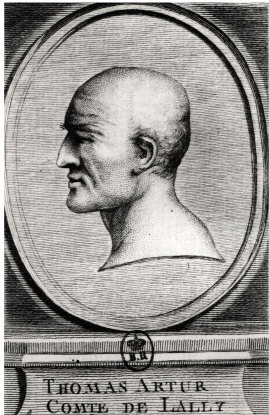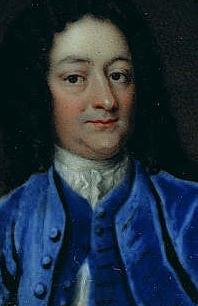|
Thomas Arthur, Comte De Lally
Thomas Arthur, comte de Lally, baron de Tollendal (13 January 17029 May 1766) was a French general of Irish Jacobite ancestry. Lally commanded French forces, including two battalions of his own red-coated Regiment of Lally of the Irish Brigade, in India during the Seven Years' War. After a failed attempt to capture Madras he lost the Battle of Wandiwash to British forces under Eyre Coote and then was forced to surrender the remaining French post at Pondicherry. After time spent as a prisoner of war in Britain, Lally voluntarily returned to France to face charges where he was beheaded for his alleged failures in India. Ultimately the jealousies and disloyalties of other officers, together with insufficient resources and limited naval support prevented Lally from securing India for France. In 1778, he was publicly exonerated by Louis XVI from his alleged crime. Life He was born at Romans-sur-Isère, Dauphiné, the son of Sir Gerald Lally, an Irish Jacobite from Tuam, ... [...More Info...] [...Related Items...] OR: [Wikipedia] [Google] [Baidu] |
Conn Of The Hundred Battles
Conn Cétchathach (; "of the Hundred Battles"), son of Fedlimid Rechtmar, was a semi-legendary High King of Ireland and the ancestor of the Connachta, and, through his descendant Niall Noígiallach, the Uí Néill dynasties, which dominated Ireland in the early Middle Ages. Literary tradition Early life and accession The ''Annals of the Four Masters'' says that five roads to Tara, which had never been seen before, were discovered on the night of Conn's birth. According to the '' Lebor Gabála Érenn'', he took power after killing his predecessor Cathair Mór. In other sources his predecessor is Dáire Doimthech. The ''Lia Fáil'', the coronation stone at Tara which was said to roar when the rightful king stood on it, roared under Conn for the first time since Cúchulainn split it with his sword when it failed to roar for Lugaid Riab nDerg. In the saga ''Baile in Scáil'' ("The Phantom's Ecstatic Vision"), Conn treads on the stone by accident while walking the ramparts of ... [...More Info...] [...Related Items...] OR: [Wikipedia] [Google] [Baidu] |
Maréchal De Camp
''Maréchal de camp'' (sometimes incorrectly translated as field marshal) was a general officer rank used by the French Army until 1848. The rank originated from the older rank of sergeant major general (French: ''sergent-major général''). Sergeant major general was third in command in an army, after the general and the lieutenant general. One of his tasks was to dispose the troops on the battlefield. It was also known in the French army as the "battle sergeant" (fr: ''sergent de bataille''). In English-speaking countries, the rank of sergeant major general became known as simply major general. Background and history The ''maréchal de camp'' rank was the junior of the two officer general ranks of the French Army, the senior being lieutenant general. The rank of brigadier was intermediate between those of colonel and ''maréchal de camp'', but was not considered a general officer rank. Nevertheless, when rank insignia were introduced in the 1770s, the brigadier insignia was o ... [...More Info...] [...Related Items...] OR: [Wikipedia] [Google] [Baidu] |
Siege Of Maastricht (1748)
The siege of Maastricht took place in April–May 1748 during the War of the Austrian Succession. A French force under the overall command of Maurice de Saxe besieged and captured the Dutch barrier fortress of Maastricht in the final few months of the campaign in the Low Countries. After a relatively long siege the garrison of Maastricht capitulated and marched out with the honours of war. Maastricht was returned along with France's conquests in the Austrian Netherlands according to the Treaty of Aix-la-Chapelle signed in 1748. Among the defenders were the Austro-Walloon Regiment of Los Rios, commanded by its Colonel Jean Charles Joseph, Count of Merode, Marquis of Deynze ; Charles, 5th Duke of Arenberg (Jean Charles' ''brother-in-law'') References * Browning, Reed. ''The War of the Austrian Succession''. Alan Sutton Publishing, 1994. Sources * Conflicts in 1748 1748 in the Dutch Republic Sieges of the War of the Austrian Succession Sieges involving the Dutch Rep ... [...More Info...] [...Related Items...] OR: [Wikipedia] [Google] [Baidu] |
Low Countries
The term Low Countries, also known as the Low Lands ( nl, de Lage Landen, french: les Pays-Bas, lb, déi Niddereg Lännereien) and historically called the Netherlands ( nl, de Nederlanden), Flanders, or Belgica, is a coastal lowland region in Northwestern Europe forming the lower basin of the Rhine–Meuse–Scheldt delta and consisting of three countries: Belgium, the Netherlands and Luxembourg. Geographically and historically, the area also includes parts of France and Germany such as the French Flanders and the German regions of East Frisia and Cleves. During the Middle Ages, the Low Countries were divided into numerous semi-independent principalities. Historically, the regions without access to the sea linked themselves politically and economically to those with access to form various unions of ports and hinterland, stretching inland as far as parts of the German Rhineland. Because of this, nowadays not only physically low-altitude areas, but also some hilly or elevated ... [...More Info...] [...Related Items...] OR: [Wikipedia] [Google] [Baidu] |
Maurice, Comte De Saxe
Maurice, Count of Saxony (german: Hermann Moritz von Sachsen, french: Maurice de Saxe; 28 October 1696 – 20 November 1750) was a notable soldier, officer and a famed military commander of the 18th century. The illegitimate son of Augustus II the Strong, King of Poland and Elector of Saxony, he initially served in the Army of the Holy Roman Empire, then the Imperial Army before finally entering French service. De Saxe became a Marshal and even Marshal General of France. He is best known for his deeds in the War of the Austrian Succession and especially for his decisive victory at the Battle of Fontenoy. He is honoured by the Walhalla Memorial. Childhood Maurice was born at Goslar, an illegitimate son of Augustus II the Strong, King of Poland and Elector of Saxony, and the Countess Maria Aurora of Königsmarck. He was the first of eight extramarital children whom August acknowledged, although as many as 354 are claimed by sources, including Wilhelmine of Bayreuth, to h ... [...More Info...] [...Related Items...] OR: [Wikipedia] [Google] [Baidu] |
Battle Of Falkirk (1746)
The Battle of Falkirk Muir (Scottish Gaelic: ''Blàr na h-Eaglaise Brice''), also known as the Battle of Falkirk, took place on 17 January 1746 during the Jacobite rising of 1745. Although it resulted in a Jacobite victory, their inability to take advantage meant it ultimately had little impact on the campaign. Following their withdrawal from England in December 1745, the Jacobite army besieged Stirling Castle in early January. One of the strongest positions in Scotland, they made little progress and government forces under Henry Hawley advanced north from Edinburgh to relieve it. He reached Falkirk on 15 January but was taken by surprise when the Jacobites attacked late in the afternoon of 17 January. Fought in failing light and heavy snow, Hawley's left wing was routed but his right held firm and for a while both sides believed themselves to have been defeated. As a result of this confusion, the Jacobites failed to follow up their victory, leading to bitter disputes over res ... [...More Info...] [...Related Items...] OR: [Wikipedia] [Google] [Baidu] |
Scotland
Scotland (, ) is a country that is part of the United Kingdom. Covering the northern third of the island of Great Britain, mainland Scotland has a border with England to the southeast and is otherwise surrounded by the Atlantic Ocean to the north and west, the North Sea to the northeast and east, and the Irish Sea to the south. It also contains more than 790 islands, principally in the archipelagos of the Hebrides and the Northern Isles. Most of the population, including the capital Edinburgh, is concentrated in the Central Belt—the plain between the Scottish Highlands and the Southern Uplands—in the Scottish Lowlands. Scotland is divided into 32 administrative subdivisions or local authorities, known as council areas. Glasgow City is the largest council area in terms of population, with Highland being the largest in terms of area. Limited self-governing power, covering matters such as education, social services and roads and transportation, is devolved from the ... [...More Info...] [...Related Items...] OR: [Wikipedia] [Google] [Baidu] |
Charles Edward Stuart
Charles Edward Louis John Sylvester Maria Casimir Stuart (20 December 1720 – 30 January 1788) was the elder son of James Francis Edward Stuart, grandson of James II and VII, and the Stuart claimant to the thrones of England, Scotland and Ireland from 1766 as Charles III. During his lifetime, he was also known as "the Young Pretender" and "the Young Chevalier"; in popular memory, he is known as Bonnie Prince Charlie. Born in Rome to the exiled Stuart court, he spent much of his early and later life in Italy. In 1744, he travelled to France to take part in a planned invasion to restore the Stuart monarchy under his father. When the French fleet was partly wrecked by storms, Charles resolved to proceed to Scotland following discussion with leading Jacobites. This resulted in Charles landing by ship on the west coast of Scotland, leading to the Jacobite rising of 1745. The Jacobite forces under Charles initially achieved several victories in the field, including the Battle ... [...More Info...] [...Related Items...] OR: [Wikipedia] [Google] [Baidu] |
Louis XV Of France
Louis XV (15 February 1710 – 10 May 1774), known as Louis the Beloved (french: le Bien-Aimé), was King of France from 1 September 1715 until his death in 1774. He succeeded his great-grandfather Louis XIV at the age of five. Until he reached maturity (then defined as his 13th birthday) on 15 February 1723, the kingdom was ruled by his grand-uncle Philippe II, Duke of Orléans, as Regent of France. Cardinal Fleury was chief minister from 1726 until his death in 1743, at which time the king took sole control of the kingdom. His reign of almost 59 years (from 1715 to 1774) was the second longest in the history of France, exceeded only by his predecessor, Louis XIV, who had ruled for 72 years (from 1643 to 1715). In 1748, Louis returned the Austrian Netherlands, won at the Battle of Fontenoy of 1745. He ceded New France in North America to Great Britain and Spain at the conclusion of the disastrous Seven Years' War in 1763. He incorporated the territories of the Duchy of L ... [...More Info...] [...Related Items...] OR: [Wikipedia] [Google] [Baidu] |
Brigadier
Brigadier is a military rank, the seniority of which depends on the country. In some countries, it is a senior rank above colonel, equivalent to a brigadier general or commodore, typically commanding a brigade of several thousand soldiers. In other countries, it is a non-commissioned rank. Origins and history The word and rank of "Brigadier" originates from France. In the French Army, the Brigadier des Armées du Roi (Brigadier of the King's Armies) was a general officer rank, created in 1657. It was an intermediate between the rank of Mestre de camp and that of Maréchal de camp. The rank was first created in the cavalry at the instigation of Marshal Turenne on June 8, 1657, then in the infantry on March 17, 1668, and in the dragoons on April 15, 1672. In peacetime, the brigadier commanded his regiment and, in maneuvers or in wartime, he commanded two or three - or even four - regiments combined to form a brigade (including his own, but later the rank was also awarded ... [...More Info...] [...Related Items...] OR: [Wikipedia] [Google] [Baidu] |






